The Race to the Moon
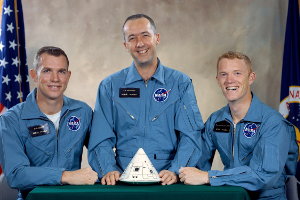 Apollo 9 was a full-throttle test of most of the systems that would be needed to land on the Moon. The crew, spacecraft, and systems passed with flying colors. The crew for this third manned mission to leave the surface of the Earth were Gemini veteran Commander Jim McDivitt (left, center), Gemini veteran and Command Module Pilot Dave Scott (left, left), and Lunar Module Pilot Rusty Schweickart (left, right). Apollo 9 was a full-throttle test of most of the systems that would be needed to land on the Moon. The crew, spacecraft, and systems passed with flying colors. The crew for this third manned mission to leave the surface of the Earth were Gemini veteran Commander Jim McDivitt (left, center), Gemini veteran and Command Module Pilot Dave Scott (left, left), and Lunar Module Pilot Rusty Schweickart (left, right).
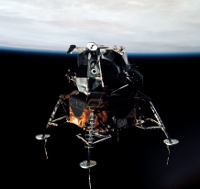
A big highlight for the crew was on the fifth day of the 10-day mission. McDivitt and Schweikart climbed into the lunar module and flew it more than 100 miles away from the command module. In a rehearsal for what astronauts who had walked on the Moon would later do, the lunar module crew then enticed their spacecraft to "rise" again, and they docked safely with Scott in the command module. (This was the second docking test done; the first was while the lunar module was still attached to the remaining stages of the Saturn rocket that launched the spacecraft.) Their tests finished and 152 orbits completed, the crew returned safety to Earth, splashing down in the Atlantic Ocean on March 13. Apollo 10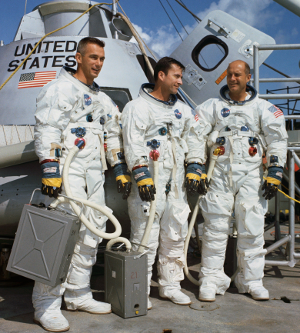 Launch date for the next mission, Apollo 10, was May 18, 1969. Three days later, the spacecraft was in orbit around the Moon. The plan was always a full dress rehearsal, to do everything but land on the Moon. The crew did just that. The crew of Apollo 10 were Commander Thomas Stafford, Command Module Pilot John Young, and Lunar Module Pilot Eugene Cernan. In the most critical test yet, Cernan and Stafford climbed into the Lunar Module and descended to less than 47,000 feet above the Moon. They made two passes over what would become the Sea of Tranquillity landing site for Apollo 11, tested all manner of systems–attitude control, communications, propulsion, and radar–and then successfully rejoined Young in the Command Module.
Launch date for the next mission, Apollo 10, was May 18, 1969. Three days later, the spacecraft was in orbit around the Moon. The plan was always a full dress rehearsal, to do everything but land on the Moon. The crew did just that. The crew of Apollo 10 were Commander Thomas Stafford, Command Module Pilot John Young, and Lunar Module Pilot Eugene Cernan. In the most critical test yet, Cernan and Stafford climbed into the Lunar Module and descended to less than 47,000 feet above the Moon. They made two passes over what would become the Sea of Tranquillity landing site for Apollo 11, tested all manner of systems–attitude control, communications, propulsion, and radar–and then successfully rejoined Young in the Command Module.
The Apollo 10 crew also took a large number of photos and compiled a large amount of color video footage–of spaceflight, of docking, of rendezvous, of the lunar surface, of the Earth. The crew had made the next mission possible. They had tested out every system that the next crew would need to employ, and all had worked within established parameters. As had been the case with previous missions, the technical glitches that they worked through (including a potentially deadly roll during the lunar module descent) gave NASA valuable information with which to plan for future challenges. The success of the mission gave NASA confidence that the next one could be as successful as it was planned to be. Apollo 11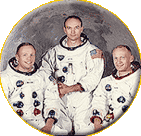 After 10 missions, getting ever closer to the landing, NASA launched Apollo 11 on July 16. An audience of an estimated 1 million people crowded the larger vicinity of the launch site. The crew turned their interior broadcast cameras on twice in the first three days of the mission, beaming back to Earth the various things that they were doing in anticipation of landing on the Moon. Their third pre-landing broadcast showed pictures of the lunar surface and illustrated their flight path. Four days later, first Neil Armstrong and then Buzz Aldrin set foot on the Moon. Michael Collins remained behind in the command module. After 10 missions, getting ever closer to the landing, NASA launched Apollo 11 on July 16. An audience of an estimated 1 million people crowded the larger vicinity of the launch site. The crew turned their interior broadcast cameras on twice in the first three days of the mission, beaming back to Earth the various things that they were doing in anticipation of landing on the Moon. Their third pre-landing broadcast showed pictures of the lunar surface and illustrated their flight path. Four days later, first Neil Armstrong and then Buzz Aldrin set foot on the Moon. Michael Collins remained behind in the command module.
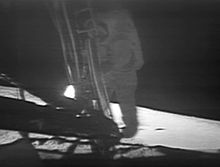
Armstrong and Aldrin had a nervous moment just before touchdown. Once they were nearly on top of the landing site, they discovered that it had too many boulders for their liking. Armstrong took over manual control and steered the spacecraft a bit further on, to a more preferred landing spot. They reached the surface with their fuel nearly gone. The Eagle, as the Lunar Module was known, touched down at 4:17 p.m. Eastern Time. But the crew didn't leave the spacecraft right away. They spent two hours going through an extensive systems check, making sure that all was go for the intended stay on the surface. They also had a bite to eat. The schedule of events as set out by NASA then called for them to rest for another four hours, on the theory that they would have been tired from the flight so far. Adrenaline won out over scheduling, and Armstrong descended the ladder at 11:56 p.m., setting foot on another world for the first time in human history. His now famous first words were, "That's one small step for man, one giant leap for mankind." 
Twenty minutes later, Aldrin joined Armstrong on the lunar surface. An exterior camera had captured Armstrong's descent and first footsteps and beamed them back to Earth in real time, to an audience that has been estimated at 650 million people. The same was true for Aldrin, who had the added benefit of being photographed by Armstrong. In fact, most still photographs of the pair on the Moon are of Aldrin for the simple reason that Armstrong was the mission photographer and so was holding the camera most of the time. Perhaps the most famous photo of this first landing on the Moon is the shot of Aldrin, with his visor showing a reflection of Armstrong. Armstrong and Aldrin were on the lunar surface for less than three hours. During that time, once they had spoken to President Richard Nixon in a live broadcast, they got down to business, conducting samples of lunar soil, rocks, and crust. They also solemnly placed on the surface memorial patches and medallions to honor those who had died in the line of space duty: theApollo 1 crew of Gus Grissom, Ed White, and Roger Chaffee, who died in the launchpad fire that nearly stymied the Apollo program, and cosmonauts Vladimir Komarov, the Soviet cosmonaut who died when Soyuz 1 crashed in 1967, and Yuri Gagarin, the first human in space, who had died in a crash in 1968. Among the other things they left was a small silicon disk containing goodwill message from 73 countries. They successfully rendezvoused with Collins in Columbia, the command module, and made their way back to Earth, making two more TV broadcasts along the way and then splashing down safely in the Pacific Ocean on July 24. They spent 21 days in quarantine before moving to Houston. They were celebrated nationwide and worldwide, attending many state dinners and being the main celebrants in parades attended by hundreds of thousands of people. The first of six moon landings, Apollo 11 set the tone for future expeditions by excavating rocks and dust from the Moon's surface and testing the effects of less-than-Earth gravity on such things as men and machines. The expedition was a huge hit, sparking interest in space exploration around the world. Next page > More Success and a Near-disaster > Page 1, 2, 3, 4, 5, 6, 7, 8 |
|
Social Studies for Kids
copyright 2002–2025
David White




